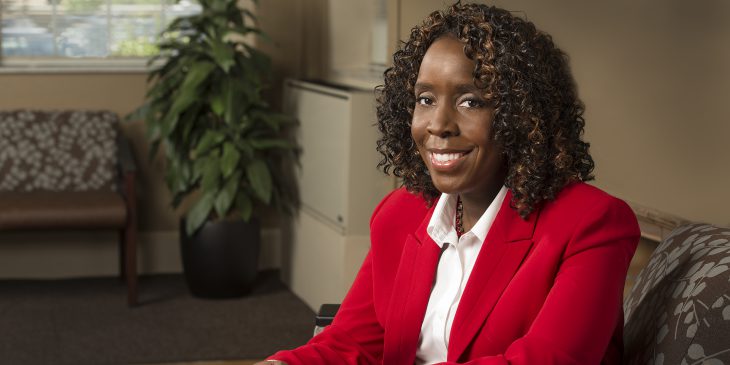Dawndra Jones, D.N.P., chief nursing officer (CNO) and vice president, Patient Care Services, UPMC East and UPMC McKeesport, was introduced to health care early, and knew nursing was her calling. On her first day at UPMC Shadyside, she never imagined she was going to be a CNO, but since the beginning of her career, she was introduced to some “awesome nursing leaders,” who began to shape her trajectory as a nurse leader.
A Moment She’ll Never Forget
As a brand-new nurse, Jones sauntered into a hospital room at UPMC Shadyside with her preceptor, wearing her white uniform, her stethoscope around her neck, clipboard in hand. The patient turned to her and said, “Oh honey, you can take the tray. It’s right over there.”
Jones had just graduated at the top of her class. She took a moment to pause. “I’ll be happy to take your tray after I do your assessment and introduce myself,” she said. Her preceptor never addressed the incident.
She explained that her experience isn’t isolated. Jones recalls times when patients have voiced specifically not wanting an African American nurse to take care of them. “How does that make people feel?” she asks rhetorically, with a hint of desire for an answer. “I believe we all have our challenges, but I believe that mine are a little bit different.”
Jones says she is often the “different one” in the CNO crowd. “I know that when I walk into a room, and people know the CNO is coming, people see me and still look for the CNO.”
Across UPMC, the nursing staff population is 93% white women. However, this lack of racial diversity is not unique to UPMC; it is a familiar refrain across the nation. “There’s still disparity in our nursing workforce,” says Jones. “If you look like me and identify as an African American in southwestern Pennsylvania, you are three times less likely than a Caucasian to be a nurse. If you go up to the Erie area, it’s six times less likely.”
Jones explains that through UPMC Health Plan data, it’s been found that health disparities exist in our communities, and she sits on the UPMC McKeesport faith-based call-to-action team, which is working to help decrease this. “I feel like as an African American, I just want to make sure I’m giving back to my community.”
Her work within and outside of UPMC reflects her desire to give back. Jones served as the co-chair of the PA Action Coalition‘s Diversity Council. She serves as the president of Pittsburgh Black Nurses in Action, which is the local chapter of the National Black Nurses Association, and she has launched the Future Nurses Academy, which supports diverse nurses through nursing school.
Research has shown that if you can decrease disparity in the nursing workforce, you can also decrease the health disparity in that population. “That is our mission along with achieving health equity for all,” said Jones. “I’m passionate about trying to improve that disparity.”
Bridging the Gaps
UPMC has committed to bridging gaps in health care and workforce diversity through a number of programs, including the UPMC Nurse Inclusion Council, the Minority Nurse Mentorship and Professional Enhancement Program and the UPMC Scholars Program.
Jones is particularly proud that UPMC has supported Pittsburgh Black Nurses in Action and the Future Nurses Academy. In 2019, there wasn’t a call for grants for the Future Nurses Academy, but there were nurses who wanted to participate. UPMC stepped in and funded its gap year. “Because of UPMC, we were able to have 11 students within that program last year.”
“When People Say They Don’t See Color, Then They Don’t See Me.” — Dawndra Jones
Over the years, Jones has observed that people surround themselves with those who look like them and tend to be comfortable with people who look like them, but she makes it a point to challenge that mindset.
“I’m always looking for people on my team who are different. I don’t need somebody else who is just like me. If we have a diverse leadership team, we can impact a diverse workforce. Diversity in everything — not just race or ethnicity. Diversity in thought,” she shares. “We must be willing and open to others’ perspectives and appreciate that others’ experiences have made them who they are. I want to be warm and welcoming to all. When you create connections with everyone, it creates that fulfilling environment for everybody.”
This is a concept that she fully embodies with her whole being. Walking into Jones’ office is like walking into a warm hug. She greets those who enter like they’re old friends — or new ones.
“It has to be a conscious effort on everybody’s part — to learn about each other,” she advises.








